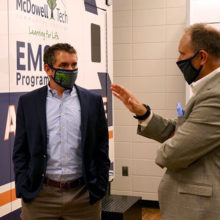Beginning in November 2017, I began a journey to visit nearly 30 community colleges by the end of the year.
At EdNC, we travel because it is our favorite way to learn about our state. The combination of being in community and using our Reach NC Voices technology allows us to surface issues that may not be on the radar of statewide leaders. On the road, we connect to residents, community institutions, and organizations who provide us with a pulse on the state.
In August 2018, our team collectively traveled to all 58 community colleges. We went to most of the 58 in one week to document the stories of the campuses, identify strengths and challenges, and build relationships.
During the same week as our statewide tour, we launched our Awake58 newsletter, which is designed to provide a weekly look at the postsecondary experience in North Carolina. From the first edition, I have tried to make the newsletter a two-way conversation versus us just sending out a collection of links.
I have found the emails from our audience to be a weekly delight. Folks have told me about the challenges of low faculty pay while also discussing the fact that their faculty role is a dream job for them. I have heard from readers regarding the opportunities ahead for customized training and work-based learning. Readers have shared ideas on a range of topics from how we might better provide wrap-around support for students of all ages to the role of K-12 and community college collaborations in bolstering educational attainment.
Our team is conducting the research to take a deeper look at the most important issues facing our community colleges. For example, we are working on a series around enrollment and historic funding patterns. And EdNC’s reporters will be walking the hallways of the legislature in 2019 covering the legislative process for community colleges.
We decided to begin our research with an issue that might be obscure to many in the state: the Residency Determination Service (RDS).
No topic generated more emails in my inbox more than RDS.
Back in October, we covered the North Carolina Community College State Board meeting:
The Board passed $380,000 for the second year of a contract with the North Carolina State Education Assistance Authority (NCSEAA) for the Residency Determination Service (RDS).
Board member Frank Johnson said of the program, “We’re funding something that actually keeps people from signing up for our community colleges.”
He then went on to say, “It prohibits people who are citizens, who are legitimate North Carolinians. This is a hurdle for them to get into our system. We need to shoot this dog. We need to get rid of it. We need to take care of it and let the legislators know that we care about this. This is an impediment to our progress in attaining full growth in our FTE, and it needs to be done.”
Spotlighting this meeting in Awake58 led to dozens and dozens of emails from community college staff across the state who wanted to share more regarding their experience with the system. It also led to a realization that RDS, which is also going to be a key item on the legislative agenda for the community college system in 2019, was worth a deep dive from our staff.
We have spent the last two months learning the ins and outs of the system. We have traveled to campuses, spoken with students, met with staff, and we have even gone through the RDS process ourselves.
We also spoke with Elizabeth McDuffie and her colleagues. McDuffie is the executive director of the North Carolina State Education Assistance Authority (SEAA). In 2015, the North Carolina General Assembly tasked SEAA with creating RDS. In a piece she authored for EdNC, she points out the prior challenges of a residency determination system that existed in the hands of the 114 individual colleges and universities across our state, which included discrepancies in residency determination for the same student from institution to institution, duplication of resources, and more.
I would encourage you to read McDuffie’s piece here:
RDS working to make fair, accurate, and efficient residency determinations
You may be asking why residency determination matters deeply to so many people. My colleague Rupen summed it up well:
Why is this all so important? On average, the annual tuition cost for an in-state student at a community college is $2,400 compared to $8,500 for an out-of-state student — a difference that can make or break an individual’s decision to pursue higher education. By simplifying the RDS application, community colleges hope more students will complete it, qualify for in-state tuition, and enroll in college.
Below is a sampling of what we found through our research and reporting:
Residency for community colleges: A look at barriers for North Carolinians seeking a better life
My colleague Rupen introduced us to Mary in his first piece:
She was careful not to do anything to establish herself in the system so she could remain in hiding.
Unfortunately, it became a threat to her ability to attend college.
After living in North Carolina for two years, she said, “You know, I have enough courage that I’m going to do something now. I’m going to invest in myself, because I’m worth it.”
But with no state records to prove her residency to qualify for in-state tuition, she needed a person to speak with and explain her situation. According to students like Mary, and the community colleges that serve them, that is not as easy to find today.
This powerful story serves as a reminder of some of the unforeseen impacts of a newly centralized RDS process. In our conversations, community college presidents and other staff members have pointed to the significant change from a personalized, one-to-one approach on campus to the centralized online system housed in Raleigh. For many of them, the challenges a prospective student such as Mary may now face outweigh the benefits of the streamlined process.
RDS, however, wasn’t created out of thin air.
Rupen pointed us to the story of Hayleigh Perez. Perez, a veteran, wanted to earn her master’s at a North Carolina institution. The GI Bill covers all tuition, provided your tuition is in-state, and so her determination mattered a whole lot. When Perez applied, two different North Carolina institutions gave her two different determinations. In response, Perez sued.
This article spotlights the design process which led our state to RDS:
RDS: A legislative creation in search of consistency and efficiency
The challenge laid down by the General Assembly was — quite simply put — a big one. Inconsistencies, which became public when a student sued after receiving contradicting residency determinations from two North Carolina universities, created a stir — and the legislature wanted change.
“It was embarrassing that they had made these different decisions,” said Elizabeth McDuffie, executive director of the State Education Assistance Authority (SEAA). “It brought a spotlight to, when you assign this and tell campuses everybody’s responsible for their own, how they follow through on it could be different. That was where the inconsistency began to come to light.”
Under SEAA’s guidance, law makers asked state agencies to collaborate, consult a 33-page manual that interpreted state residency law, solicit input and from the 16 UNC System schools, 58 community colleges, and 40 independent schools, and combine the myriad residency determination processes occurring at 114 different institutions into just one process.
And to make sure the single process got the residency determination right.
With such an immense task, an advisory committee was formed and immediately got to work. But where would they start?
“You begin with the law,” said Gwen Canady, who is chair of the working group that manages RDS.
What became the finished product has drawn criticism from community colleges for making residency determination harder for their students than it was before. But RDS officials believe they answered the call laid down by the general assembly. From their perspective, they have created the one-stop solution that the legislature wanted, and made it more convenient and quicker for applicants to learn their residency status.
“RDS today is a byproduct of a lot of input,” Canady said. “I’m a very strong proponent. It makes good sense. It makes good sense to the citizens, it makes good sense to the parents, and to the high school students. And it’s definitely on us to make it as simple as possible so that nobody feels like it’s a barrier.”
NC SEAA explained they believe they have built a system which meets their task of accurately determining in-state residency. When Rupen met with them, they pointed to the 32 different revisions to the system since RDS launched, which has provided for ongoing tweaks to meet the needs of both students and institutions. They have gotten rid of questions which were no longer needed, added additional customer service support, clarified language, and more.
“RDS is not perfect — no system is,” Canady said. “We know that. But we have been very responsive and we continue to be. We want to be sure that every student can get through it.”
Various stakeholders in the community college system, including the legislative affairs committee comprised of community college presidents, have been exploring proposals for the upcoming legislative session to amend the process.
One element of the centralized, online RDS is the ability to track where students run into roadblocks. The largest number of prospective students who have “stopped out” of the RDS process did so when they hit domicile questions. The law, as written, defaults to a view that prospective students live with their parents or a court-appointed guardian, which could easily provide a challenge for adult students, emancipated minors, or others with a range of living situations.
My colleague Molly explored the tweak the legislative affairs committee of the NC Community College President’s Association landed on in the following article:
Removing barriers: A proposal to simplify the Residency Determination Service
The current issue surrounding RDS is rooted in a law first written in the 1970s. The law entitled “Provisions for determining residency status for tuition purposes” lays out the requirements an applicant must meet to qualify as a “resident for tuition purposes.” Specifically, the applicant must have established legal residence (domicile) in North Carolina, maintained that residence for 12 consecutive months before the start of school, and intend to stay in North Carolina not merely for the sake of school.
Community colleges are not trying to change this part of the law. Instead, it is the next part, section (e) of G.S. §116-143.1, that they are hoping to get repealed. Section (e) states:
“When an individual presents evidence that the individual has living parent(s) or court-appointed guardian of the person, the legal residence of such parent(s) or guardian shall be prima facie evidence of the individual’s legal residence, which may be reinforced or rebutted relative to the age and general circumstances of the individual by the other evidence of legal residence required of or presented by the individual…”
What all that boils down to is this: if you are applying to college and your parents are alive (or you have a court-appointed guardian), then the law assumes you live with your parents or guardian unless you prove otherwise. The law goes on to state that if your parents or guardian live out of state, you are not assumed to live with them if you have lived in North Carolina for five consecutive years prior to enrolling in school.
…
So, the group proposed repealing section (e) of the residency statute (quoted above), stating in their proposal, “The law would no longer presume that the student and parents have the same domicile. The student would simply have to show his or her domicile is NC without regard to his or her parent(s).” In November, the State Board of Community Colleges approved the proposal and added it to their 2019 legislative agenda.
The hope is this change would minimize the number of prospective students who stop out during the RDS process. President John Gossett of McDowell Tech told Molly, “We’re an open door institution. I’d like to see that open door open up again. I’m not saying it closed, but it definitely moved in that direction.”
What’s next?
The North Carolina Community College system office will take their issues with RDS to the North Carolina General Assembly during the 2019 legislative session. Presidents told us they believe this is a moderate solution which stops short of requesting the community colleges being exempted from RDS, while still requesting a change they believe will help more students access community college.
One important note for the presidents is that roadblocks to access do not just harm individual students. If the RDS leads to fewer students enrolling, this impacts entire colleges. The colleges are funded on enrollment. For a small rural college, if just over one hundred students do not enroll as a result of running into challenges with RDS you could see a college reducing instructional offerings due to having to layoff staff. Enrollment matters a whole lot.
Postsecondary education can change the lives of the students who enroll, while increased enrollment can also transform institutions through giving them the resources they need to perform their mission.
When we take a step back, this seemingly obscure issue cuts to the heart of many of the challenges facing postsecondary education, ranging from making sure more students have access to education to bolstering enrollment during a sustained economic boom, to questions facing our state around our urgent need to increase the number of North Carolinians with a postsecondary degree or credential.
If this tweak doesn’t fix the challenges of RDS, you can expect a number of other proposals to be floated.
One of the most significant could be a request from the community college system to be exempt from RDS outright.
Other ideas have surfaced in our conversations.
Isothermal Community College President Walter Dalton offered his take on the path forward:
Another community college president told me he would support “one tuition” — a simplified, flat rate for in-state and out-of-state students alike. This is the model for continuing education classes, which have one fee regardless of where the student lives. This change, he posited, could lead to an increase in enrollment for border colleges, along with making the process easier for students. Even this tweak wouldn’t completely rid students of the need to undergo some sort of residency determination to satisfy financial aid requirements.
Others have suggested community college applications should default to placing students in the RDS process only after they have completed their application. The hope is this would provide the prospective student with extra motivation to complete the process, even if it means working more closely with the college, or even going through the appeals process if an out-of-state determination is reached. This tweak would also give the college a better way of reaching back out to students who stop out of RDS to provide more effective customer service.
Regardless of the ideas that continue to emerge, we will be there covering the process, and we hope our readers will remain engaged in sharing ideas, experiences, and stories to clarify and shape our coverage.



